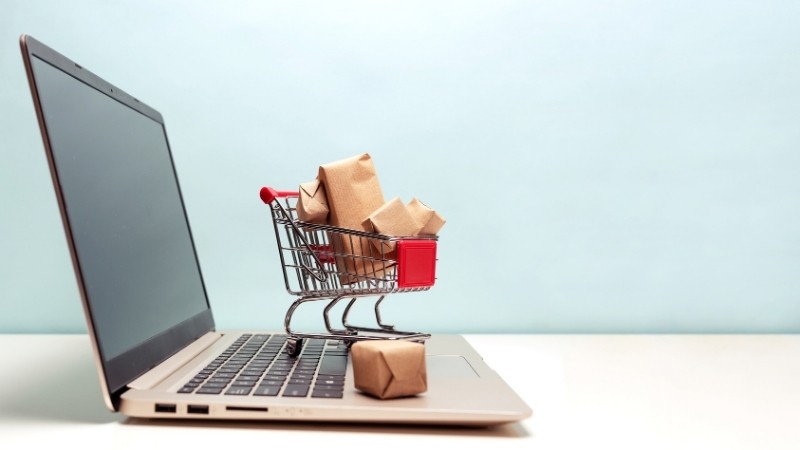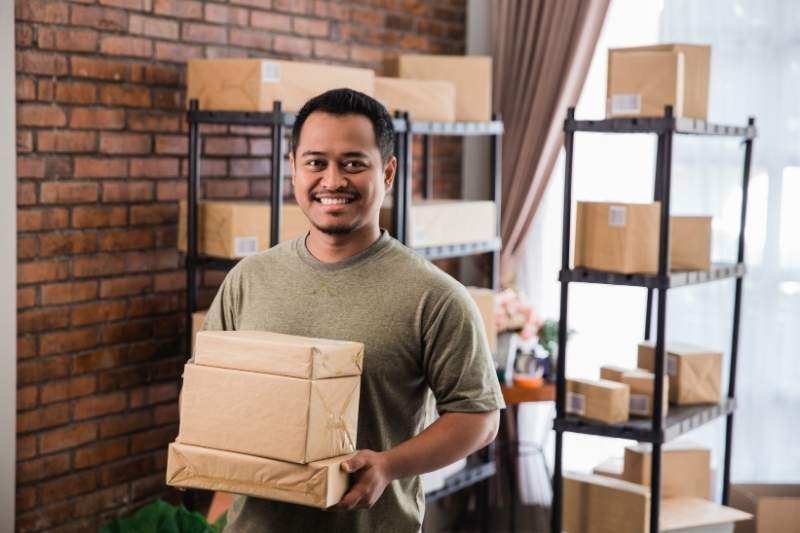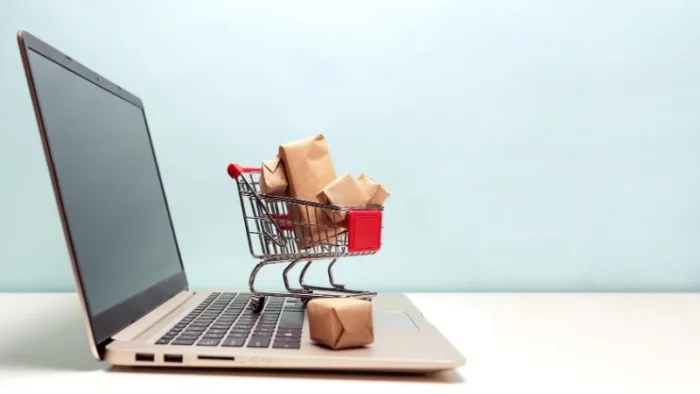Key takeaways
- The rise of online shopping has led to a surge in package deliveries, overwhelming traditional package management methods.
- Implementing a package management system helps save time and cut costs by simplifying how packages are received and stored.
- The best systems reduce manual work for staff and improve the resident experience to boost satisfaction and retention.
- ButterflyMX streamlines delivery management by enabling secure courier access and easy resident pickup using intercoms and unique codes.

Think back to the last time you bought something online. It probably wasn’t very long ago, was it? Online shopping is all the rage, and ecommerce is only growing. Retailers are better than ever at optimizing the online shopping experience and converting digital sales.
As a multifamily housing professional, you may not pay much attention to online shopping trends. But the ecommerce industry has a much bigger impact on your operations, goals, and finances than you may realize. The cost of managing a package delivery system at your building includes time, people, and money. Whether you’re just trying to learn about e-commerce trends or looking for the best package locker for your apartment building, this post is for you.
In this post, we’ll discuss:
- The rapid growth of online shopping
- Emerging trends in e-commerce
- Monitor package deliveries in one place
The rapid growth of online shopping
In 2019, ecommerce made history: For the first time ever, online shopping accounted for more than 10% of total retail sales in the U.S. Ecommerce generated a whopping $602 billion in sales in 2019, equating to a 14.9% growth in sales for the year.
Though 2019 marked a milestone in ecommerce, the industry has been steadily growing year over year. Motivations for online shopping vary from convenience to more competitive pricing to wider selections, but the fact remains that more people are buying more goods online. Data from 2018 shows that over 75% of worldwide online shoppers purchase something at least once a month.
While both men and women shop online at similar rates, one demographic that might surprise you is age. Interestingly, Gen Xers (age 40-55) shop online more than baby boomers (age 55-75) and millennials (age 25-40). Despite growing up in the digital age, millennials are pickier about their spending and want to identify with the products they purchase. Gen Xers, on the other hand, are more excited about the convenience and cost savings that come with online shopping. As for Gen Zers (age 25 and under) — they may spend 75% of their free time online, but 98% of them prefer in-store shopping.
With all this data in mind, it’s no surprise that ecommerce is only expected to grow. In fact, experts project that ecommerce sales could reach $890 billion by 2024.
Emerging trends in ecommerce
The success of ecommerce correlates with technological developments. As technology improves, so does ecommerce.
Today, digital retailers have more information and consumer insight than ever before. By leveraging this data along with emerging technologies, ecommerce businesses can improve the digital shopping experience for all demographics and maintain a steady upward trend in online shopping.
So what specifically is contributing to this boom in online shopping? How are digital retailers consistently capturing more buyers and boosting sales? Below are some of the top trends that are driving conversions online.
Ecommerce trends include:
Learn how to create and manage delivery PINs with ButterflyMX:
1. Mobile shopping
Currently, about 49% of online purchases are made through a mobile device. In 2021, roughly 54% of digital purchases were made on mobile devices instead of desktops and laptops. As the generation that spends the most time on their phones, Gen Zers are the primary target for mobile shopping.
To accommodate the shift to mobile shopping, ecommerce businesses have made considerable efforts to optimize their websites and apps for mobile devices. Many companies design completely separate websites and ecommerce interfaces specifically for mobile. The shopping experience needs to be seamless — otherwise, customers may bounce from the webpage or abandon their carts.
Since the smartphone isn’t going anywhere, the mobile shopping trend is expected to persist. As more consumers start shopping on their phones, digital sales will likely increase, as shoppers can make purchases from anywhere, at any time.

2. Personalized commerce
Personalized commerce is the act — and the art — of delivering customized shopping experiences by showing content, product recommendations, and offers tailored to each customer.
Personalizations are based on the customer’s:
- Browsing history
- Search engine queries
- Past purchases
- Demographics
- Clicks and time spent on pages
Personalized commerce works so well because it mimics the human element of in-store shopping. In brick-and-mortar stores, salespeople provide the personalized touch by reminding customers of sales, helping them find specific items, and recommending products.
The ecommerce industry is investing more and more in personalization to make up for the lack of human salespeople. Studies show that customers spend 48% more when their shopping experience is personalized, so this trend has a huge impact on sales.
3. AI and machine learning
Artificial intelligence (AI) and machine learning seem to be popping up in every industry, but they certainly play a significant role in the future of online shopping.
AI is paramount to creating personalized ecommerce experiences. However, it’s also invaluable for providing exceptional customer support and predicting consumer behavior.
AI tools that can be used in ecommerce include:
- Chatbots to respond to customers’ questions about a brand or its products 24/7.
- AI pricing tools to deliver optimized pricing and sales and increase conversions.
- Demand forecasting tools to predict product trends and consumer demand.
- Virtual personal shoppers, which use everything from customers’ voice searches to their travel plans to recommend suitable products.
4. Social media shopping
We know that mobile shopping is on the rise — and that’s thanks largely to social media. Apps like Instagram, Facebook, and TikTok are wisely diving into the ecommerce space, offering retailers the potential to reach new audiences and increase conversions.
Instagram Shopping lets businesses sell on the app by making shoppable Instagram posts. All you have to do is set up an Instagram business profile and connect your ecommerce website. In your posts, you can link directly to multiple products.
Introduced in May 2020, Facebook Shops lets you connect your ecommerce website with your Facebook business page to sell directly through the platform.
Even TikTok wants a piece of the ecommerce pie. In late 2019, the app reportedly started testing a feature that lets creators place links to ecommerce sites in their videos and profiles. Later, in October 2020, TikTok announced a partnership with ecommerce platform Shopify to let Shopify merchants create and share in-feed video ads for their products.
Social media usage around the world is only growing. As of 2019, 72% of U.S. adults use social media in some capacity. And platforms like Instagram and Facebook give ecommerce businesses the power not only to sell through new channels but to reach and influence new audiences.
How ecommerce affects multifamily housing
In 2019, roughly 224 million Americans purchased something online. And as of 2017, roughly 39 million Americans live in apartments. You don’t have to do the math to know that that adds up to a lot of packages delivered to apartments every day.
Logically, with more online orders come more package deliveries. Couriers handle the shipping logistics, but as a property manager or owner, your job is to ensure those deliveries make it to your residents. And that’s easier said than done.
Even if your building can manage its current rate of package deliveries, are you prepared for the inevitable future where 25%, or even 50%, of all retail sales are made online? What about the holiday season, when deliveries increase exponentially in November and December?
With online shopping trends and ecommerce growth in mind, it might be time to reconsider the package management process at your multifamily building.
Why you need a multifamily package management solution
Package management solutions like package lockers and package rooms streamline the delivery process, keep packages safe, and ensure that residents always get their packages on time.
You should invest in a multifamily package management system for three key reasons:

1. Reduce strain and save time for staff
In a 2018 NMHC survey, 68% of property staff reported spending between one to four hours per week managing packages. And staff spend even more time on package management around Black Friday, the holidays, and other high-volume periods. That time could be much better spent on important tasks like securing the building, managing guests, and engaging with residents.
2. Save money
Do you know how much it costs to manage deliveries at your building? Not only do multifamily package management solutions help save time, but they also cut costs.
Think about it: Every hour your staff spends on package intake and storage is an hour you’re paying them to forgo other tasks that contribute to keeping residents happy and maintaining the building. Those hours add up quickly.
3. Delight and retain residents
Ecommerce growth has resulted in people buying all kinds of products online. These days, packages as small as jewelry and as large as a sofa could show up at your apartment building.
Online shoppers have high expectations. They expect orders to arrive at their doorstep quickly, without any friction along the way. This puts a lot of pressure on property or mailroom staff who are responsible for daily delivery intake and package storage.
As such, package management in multifamily buildings is no longer an optional amenity — it’s a necessity. Residents won’t re-sign the lease for an apartment that can’t efficiently manage package deliveries.
Monitor package deliveries in one place
With ButterflyMX’s package room and front desk station solution, your tenants will never miss another delivery. Further, with the ButterflyMX front desk station visitor management software, you can easily grant access to delivery personnel. From there, tenants can use the package room intercom to retrieve their delivery using their unique code.
Features of the front desk station include:
- Live video to monitor movement around the building.
- Two-way video communication with couriers and tenants.
- Guest credential authentication.
- Grant deliverers access permission at ButterflyMX-controlled gates or doors from the desktop.






